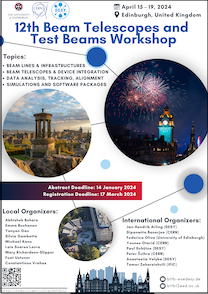Speaker
Description
A new hybrid photodetector, based on a vacuum tube containing a transmission photocatode, a microchannel plate and a CMOS pixelated read-out anode (the Timepix4 ASIC) is under development in the framework of the 4DPHOTON ERC-funded project.
This detector will allow to image single photons up to a maximum rate of 1 billion photons per second over an area of $\sim$7 cm$^2$, reaching simultaneously excellent spatial (5-10 $\mu$m) and timing (50-100 ps) resolutions.
A test-beam is planned at the CERN SPS North Area in order to characterize the performance of the first detector prototypes using a Ring-Imaging Cherenkov configuration.
The setup consists of a tracking telescope made of two Timepix4 ASICs bump-bonded semiconductor-based pixel detectors, a solid radiator for the production of Cherenkov photons, followed by an optical section that allows to focus the emitted Cherenkov photons into a ring on a set of photodetectors under study.
The Geant4 simulation of the whole experimental test-beam setup is presented. The design of the optical section that follows Cherenkov photons production is optimized using Ansys Zemax.
The analysis of the simulated data is also presented, in particular the performance in terms of tracking resolution, Cherenkov angle resolution and the photon timing resolution, which is expected to be of the order of 10~ps per single track.
